Numerical and Experimental Validation for Connecting Nature with Architecture by Mimicking Cranium into a Shell Roof
Abstract
:1. Introduction
Thrust of This Study
2. Methodology
3. Parametric and Properties
3.1. Cranium Properties
3.2. Concrete Mix Proportions
3.3. Models Shapes and Parametric Ranges
3.4. Analysis of Column Shapes to Support the Shell Roof
4. Numerical Investigation
4.1. Model of Cranium
4.2. Model of Shell Shapes
4.3. Mesh Convergence Study
4.4. Load and Boundary Condition for Shell Models
5. Numerical Analysis
5.1. Analysis of Cranium
5.2. Biomorphism of Shells
5.3. Comparison of HC Shape with Conventional Slab
5.4. Biomorphism of Water Tank
6. Comparative Analysis
6.1. Critical Stress Comparison
6.2. Displacement Comparison
7. Experimental Investigation
7.1. Design and Details of Water Tank
7.2. Fabrication and Casting of Specimen
7.3. Experimental Setup
8. Results and Discussion
8.1. General Observations
8.2. Capacity Ratio (Numerical)
8.3. Capacity Ratio (Experimental)
8.4. Comparison (Numerical and Experimental)
8.5. Load–Displacement Behavior
8.6. Crack Pattern
9. Conclusions
10. Patents
Author Contributions
Funding
Data Availability Statement
Conflicts of Interest
References
- Nasretdinova, M.; Utemuratova, G.; Dawletmuratov, A.; Matveev, A.; Kaigorodov, D.; Kalinin, E.; Mustaev, O. Advances in Biomimetics in Imitation of the Laws of Nature. J. Biomim. Biomater. Biomed. Eng. 2021, 53, 77–84. [Google Scholar] [CrossRef]
- Aziz, M.S.; El Sherif, A.Y. Biomimicry as an Approach for Bio-Inspired Structure with the Aid of Computation. Alex. Eng. J. 2016, 55, 707–714. [Google Scholar] [CrossRef]
- Rey-Rey, J. Nature as a Source of Inspiration for the Structure of the Sydney Opera House. Biomimetics 2022, 7, 24. [Google Scholar] [CrossRef] [PubMed]
- Gruber, P.; Imhof, B. Patterns of Growth-Biomimetics and Architectural Design. Buildings 2017, 7, 32. [Google Scholar] [CrossRef]
- Aulia Fikriarini, M.; Ishomuddin, M. Biomorphic Architecture Approach in Building Form Based on Environmental Concern. J. Teknol. 2016, 78, 97–202. [Google Scholar] [CrossRef]
- Sindhu Nachiar, S.; Shilpa, P.; Satyanarayanan, K.S.; Anandh, S. Modeling and Analysis of a Pin Jointed Plane Frame Using Biomimicked Structural Elements. In Proceedings of the Materials Today: Proceedings; Elsevier Ltd.: Amsterdam, The Netherlands, 2021; Volume 50, pp. 259–268. [Google Scholar]
- Sindhu Nachiar, S.; Satyanarayanan, K.S.; Lakshmipathy, M. Study on the Behaviour of Tension Member Based on the Concept of Biomimics. Mater. Today Proc. 2018, 34, 371–378. [Google Scholar] [CrossRef]
- Toader, T.N.; Mircea, C.G.R.; Truta, A.M.; Constantinescu, H. Coniferous Trees as Bioinspiration for Designing Long Reinforced Prestressed Concrete Columns. Biomimetics 2024, 9, 165. [Google Scholar] [CrossRef]
- Motherway, J.A.; Verschueren, P.; Van der Perre, G.; Vander Sloten, J.; Gilchrist, M.D. The Mechanical Properties of Cranial Bone: The Effect of Loading Rate and Cranial Sampling Position. J. Biomech. 2009, 42, 2129–2135. [Google Scholar] [CrossRef]
- Wun Huang, B.; Kuang Kung, H.; Chang, K.-Y.; Kai Hsu, P.; Tseng, J.-G. Human. Cranium Dynamic Analysis. Life Sci. J. 2009, 6, 15–22. [Google Scholar]
- Haen, P.; Dubois, G.; Goudot, P.; Schouman, T. Comparative Finite Element Analysis of Skull Mechanical Properties Following Parietal Bone Graft Harvesting in Adults. J. Cranio-Maxillofac. Surg. 2018, 46, 329–337. [Google Scholar] [CrossRef]
- Godinho, R.M.; Toro-Ibacache, V.; Fitton, L.C.; O’Higgins, P. Analyse Par Éléments Finis Du Crâne: Validité, Sensibilité et Directions Futures. Comptes Rendus Palevol 2017, 16, 600–612. [Google Scholar] [CrossRef]
- Bandhopadhyay, J.N. Thin Shell Structures Classical and Modern Analysis; New Age International Publishers: New Delhi, India, 1986. [Google Scholar]
- Abraham, R.A.; Chandran, G.K. Study of Dome Structures with Specific Focus on Monolithic and Geodesic Domes for Housing. Int. J. Emerg. Technol. Adv. Eng. 2016, 6, 173–182. [Google Scholar]
- Chatterjee, B.K. Theory and Design of Concrete Shell, 3rd ed.; Chapman & Hall: New York, NY, USA, 1988. [Google Scholar]
- Ramaswamy, G.S. Design and Constructions of Concrete Shell Roofs; CBS Publishers and Distributors: New Delhi, India, 1986. [Google Scholar]
- Sindhu Nachiar, S.; Anandh, S.; Swathi, K.; Pennarasi, G. Optimization of Thin Spherical Shell Structure Using FEM. Mater. Today Proc. 2022, 68, 17–25. [Google Scholar] [CrossRef]
- Meng, X.; Xiong, Y.; Xie, Y.M.; Sun, Y.; Zhao, Z.-L. Shape–Thickness–Topology Coupled Optimization of Free-Form Shells. Autom. Constr. 2022, 142, 104476. [Google Scholar] [CrossRef]
- Smoljanović, H.; Balić, I.; Trogrlić, B.; Živaljić, N.; Munjiza, A. Finite Strain Numerical Model for the Nonlinear Analysis of Thin Shells. Eng. Struct. 2021, 234, 111964. [Google Scholar] [CrossRef]
- Bhimaraddi, A. Static and Transient Response of Cylindrical Shells. Thin-Walled Struct. 1987, 5, 157–179. [Google Scholar] [CrossRef]
- Tech, I.M. Reinforced Cement Concrete (RCC) Dome Design SHAIK TAHASEEN. Int. J. Civ. Struct. Eng. Res. 2015, 3, 39–45. [Google Scholar]
- Kanta, N. Design of a Thin Concrete Shell Roof for a Basketball Arena of 20,000 Spectator Capacity Niladri Kanta. Master’s Thesis, Delft University of Technology, Delft, The Netherlands, 2015. [Google Scholar]
- Maali, M.; Aydın, A.C.; Showkati, H.; Sağıroğlu, M.; Kılıç, M. The Effect of Longitudinal Imperfections on Thin-Walled Conical Shells. J. Build. Eng. 2018, 20, 424–441. [Google Scholar] [CrossRef]
- Błachut, J. Minimum Weight of Internally Pressurised Domes Subject to Plastic Load Failure. Thin-Walled Struct. 1997, 27, 127–146. [Google Scholar] [CrossRef]
- Aijaz, N.; Imtiyaz, P.A.; Malik, F.A.; Sheikh, V.H. Parametric Study of Spherical Domes for Efficient Housing Construction Using Finite Element Method. Innov. Infrastruct. Solut. 2024, 9, 210. [Google Scholar] [CrossRef]
- Martínez-Martín, F.J.; Yepes, V.; González-Vidosa, F.; Hospitaler, A.; Alcalá, J. Optimization Design of RC Elevated Water Tanks under Seismic Loads. Appl. Sci. 2022, 12, 5635. [Google Scholar] [CrossRef]
- Saxena, S.; Pathak, K.K. Conventional and Ferrocement-Based Hybrid Design of RCC Tanks: A Comparative Study. Innov. Infrastruct. Solut. 2024, 9, 122. [Google Scholar] [CrossRef]
- Jan, F.; Min-Allah, N.; Saeed, S.; Iqbal, S.Z.; Ahmed, R. IoT-Based Solutions to Monitor Water Level, Leakage, and Motor Control for Smart Water Tanks. Water 2022, 14, 309. [Google Scholar] [CrossRef]
- Djalilov, A.; Sobirov, E.; Nazarov, O.; Urolov, S.; Gayipov, I. Study on Automatic Water Level Detection Process Using Ultrasonic Sensor. IOP Conf. Ser. Earth Environ. Sci. 2023, 1142, 012020. [Google Scholar] [CrossRef]
- Nasir, M.; Gazder, U.; Maslehuddin, M.; Baghabra Al-Amoudi, O.S.; Syed, I.A. Prediction of Properties of Concrete Cured Under Hot Weather Using Multivariate Regression and ANN Models. Arab. J. Sci. Eng. 2020, 45, 4111–4123. [Google Scholar] [CrossRef]
- Ali, S.; Sinha, A.P.; Jethani, S.L.; Rohatgi, R.K.; Anamika, K. Study of Cranial Capacity of Adult North Indian Human Skulls & Its Sexual Dimorphism. Int. J. Scient. Study 2014, 1, 29–31. [Google Scholar]
- Dekaban, A.; Lieberman, J.E. Calculation of Cranial Capacity from Linear Dimensions. Anat. Rec. 1964, 150, 215–219. [Google Scholar] [CrossRef]
- IS 2210; Criteria for Design of Reinforced Concrete Shell Structures and Folded Plates. Bureau of Indian Standards (BIS): New Delhi, India, 1988.
- Zapata, U.; Wang, Q. Material Properties of the Skull Layers of the Primate Parietal Bone: A Single-Subject Study. PLoS ONE 2020, 15, e0229244. [Google Scholar] [CrossRef]
- IS 12269 (2016); Ordinary Portland Cement, 53 Grade—Specification. Bureau of Indian Standards (BIS): New Delhi, India, 2016.
- IS 383 (2016); Coarse and Fine Aggregate for Concrete Specification. Bureau of Indian Standards (BIS): New Delhi, India, 2016.
- Siddique, S.; Shrivastava, S.; Chaudhary, S. Durability Properties of Bone China Ceramic Fine Aggregate Concrete. Constr. Build. Mater. 2018, 173, 323–331. [Google Scholar] [CrossRef]
- Siddique, S.; Shrivastava, S.; Chaudhary, S.; Gupta, T. Strength and Impact Resistance Properties of Concrete Containing Fine Bone China Ceramic Aggregate. Constr. Build. Mater. 2018, 169, 289–298. [Google Scholar] [CrossRef]
- Sindhu Nachiar, S.; Satyanarayanan, K.S.; Lakshmipathy, M.; Sai Pavithra, S. Study on Behaviour of Compression Members Based on Concept of Biomimics. Mater. Today Proc. 2018, 34, 518–524. [Google Scholar] [CrossRef]
- Varghese, P.C. Design of Reinforced Concrete Shells, and Folded Plates; PHI Learning Pvt. Ltd.: New Delhi, India, 2010. [Google Scholar]
- IS 3370-1 (2009); Bureau of Indian Standards IS 3370 Part I (2009): Indian Standard Concrete Structures for Storage of Liquids—Code of Practice. Bureau of Indian Standards: New Delhi, India, 2009.
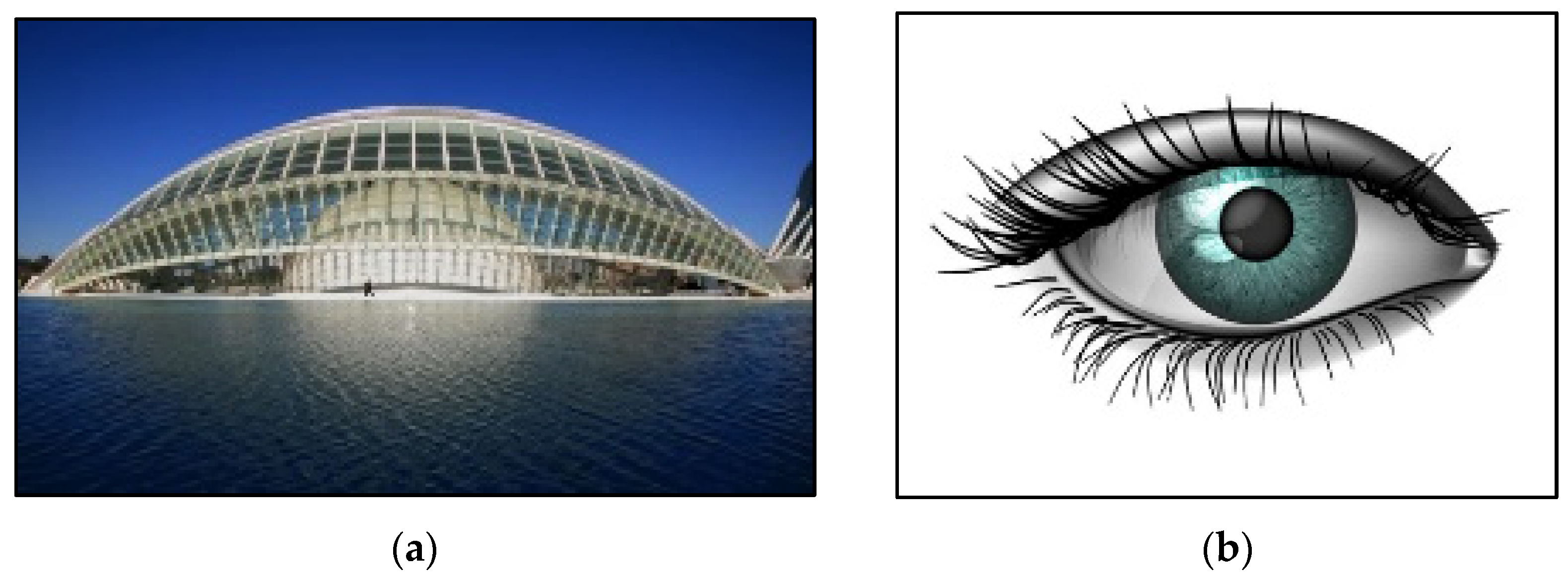

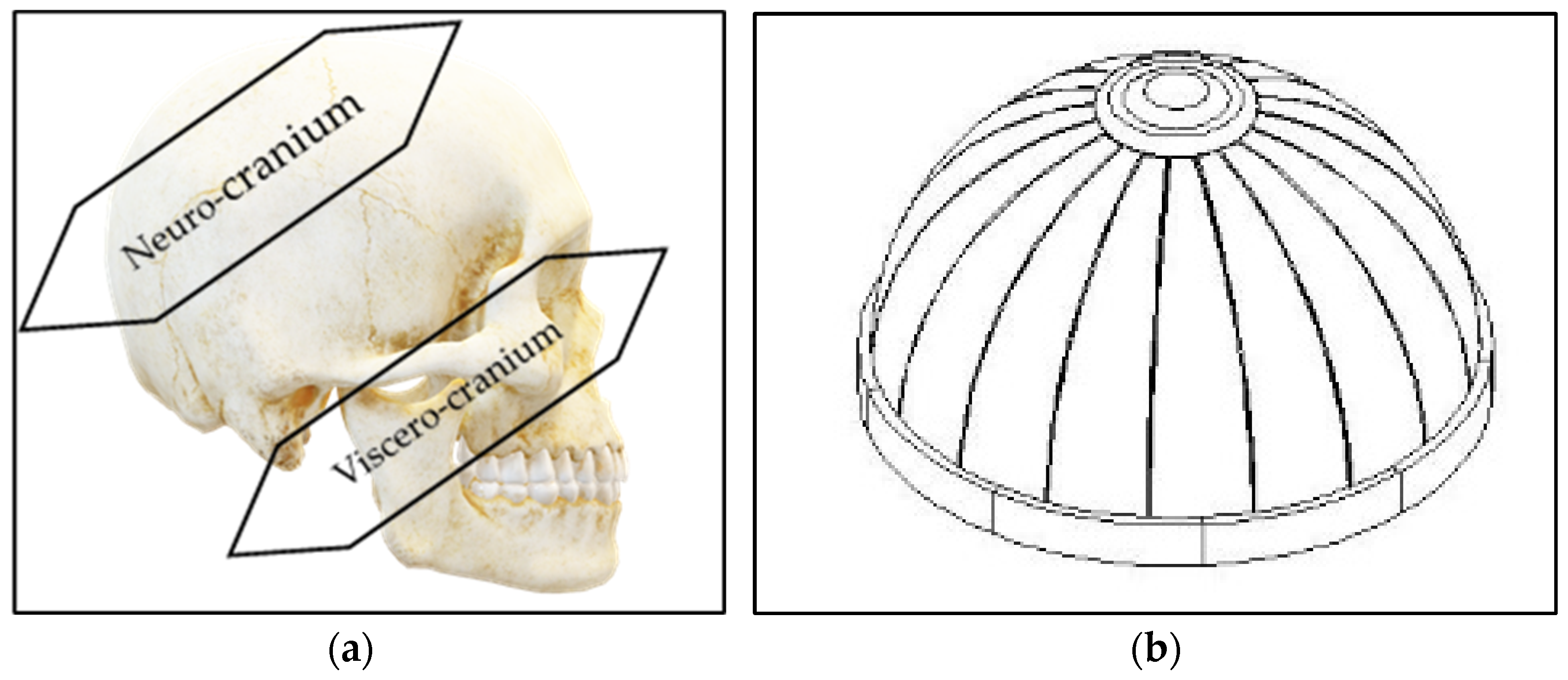

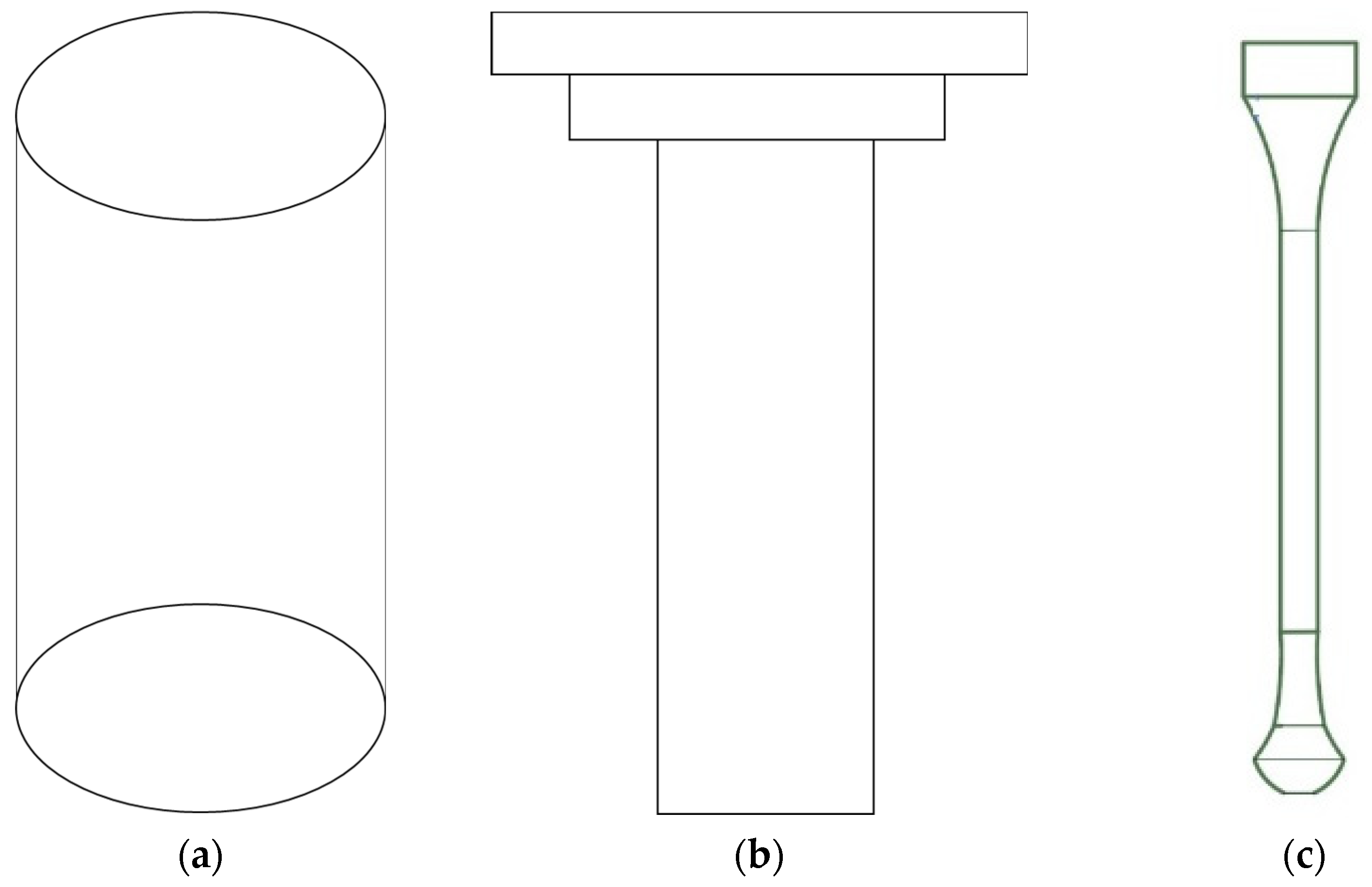

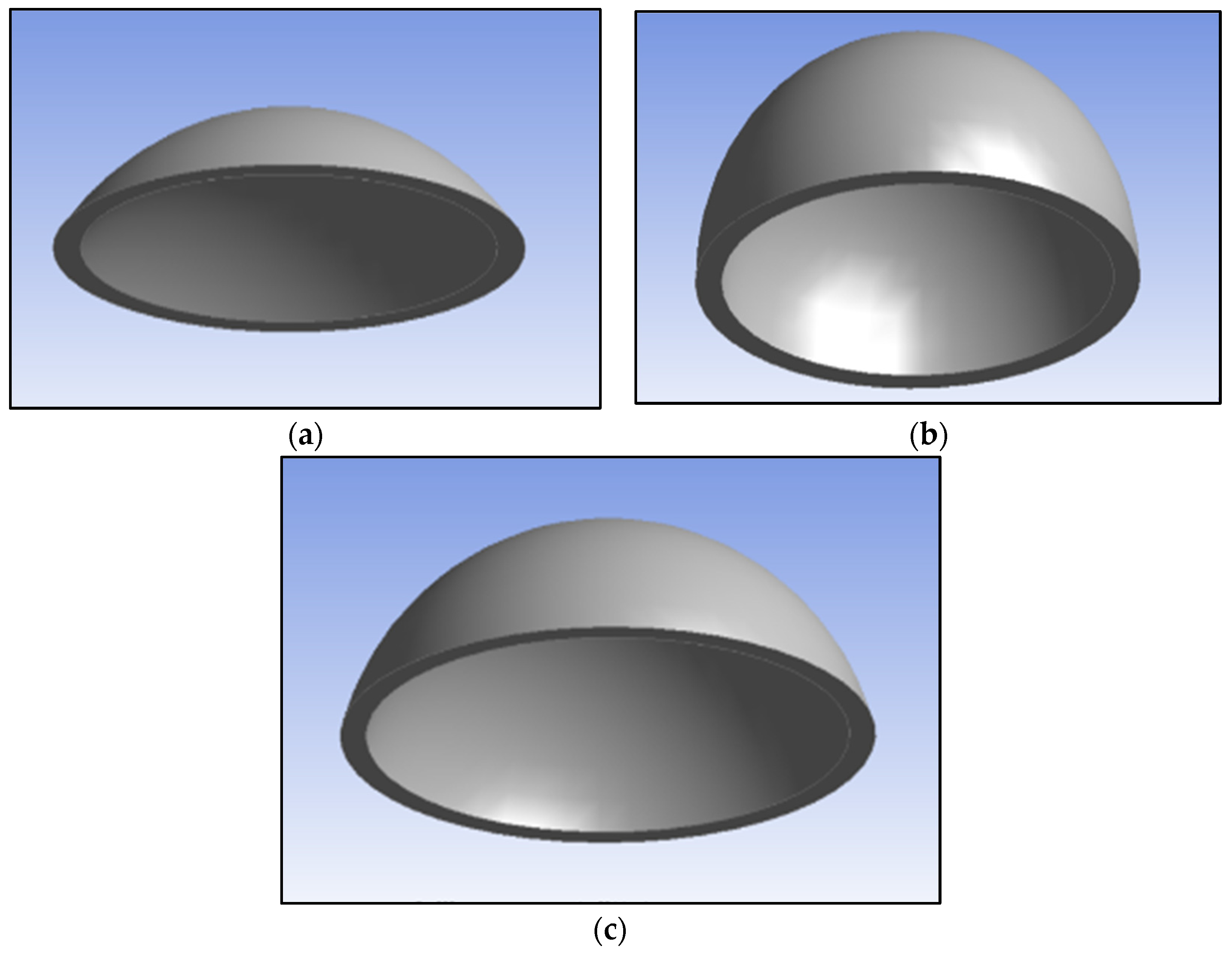

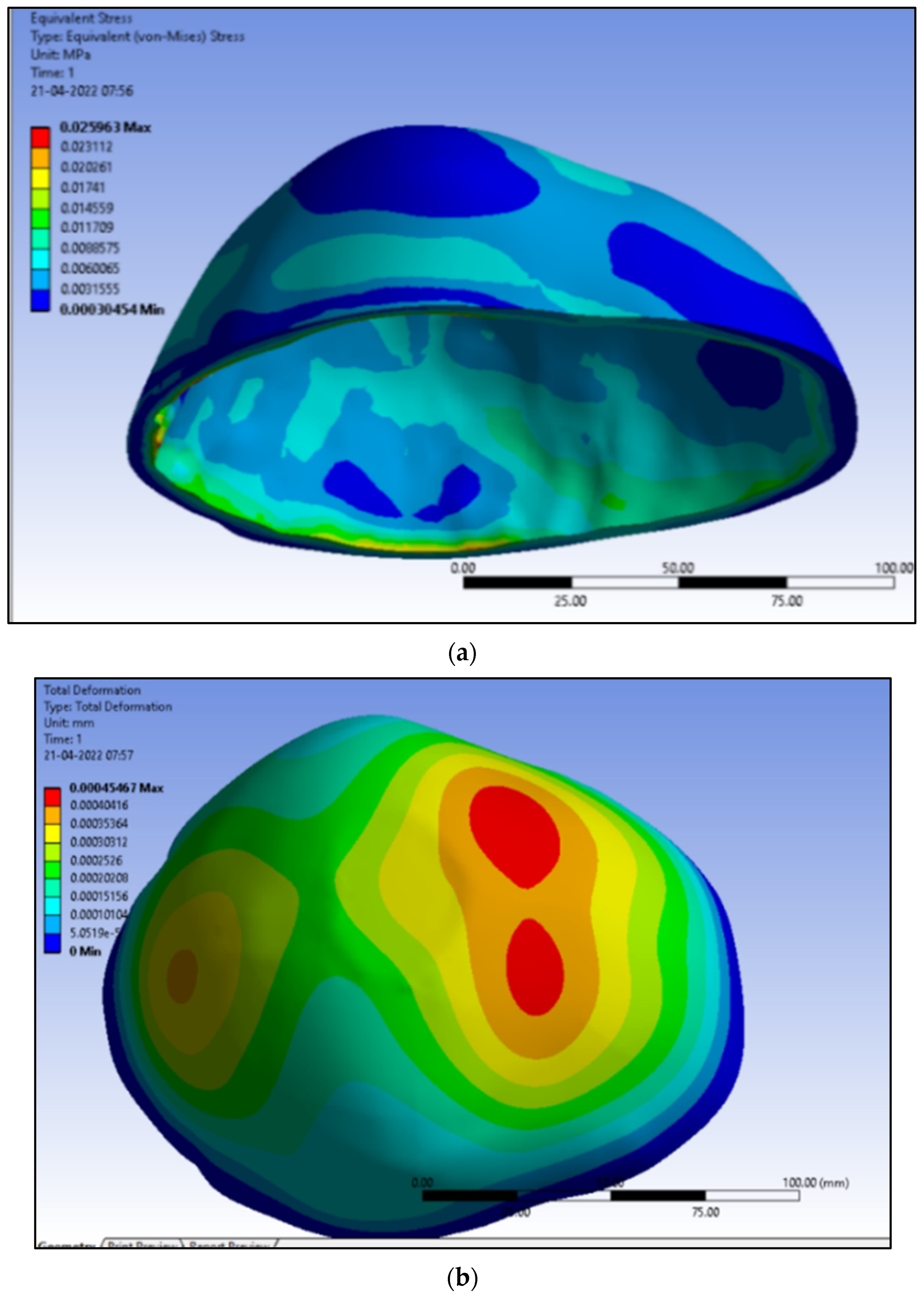

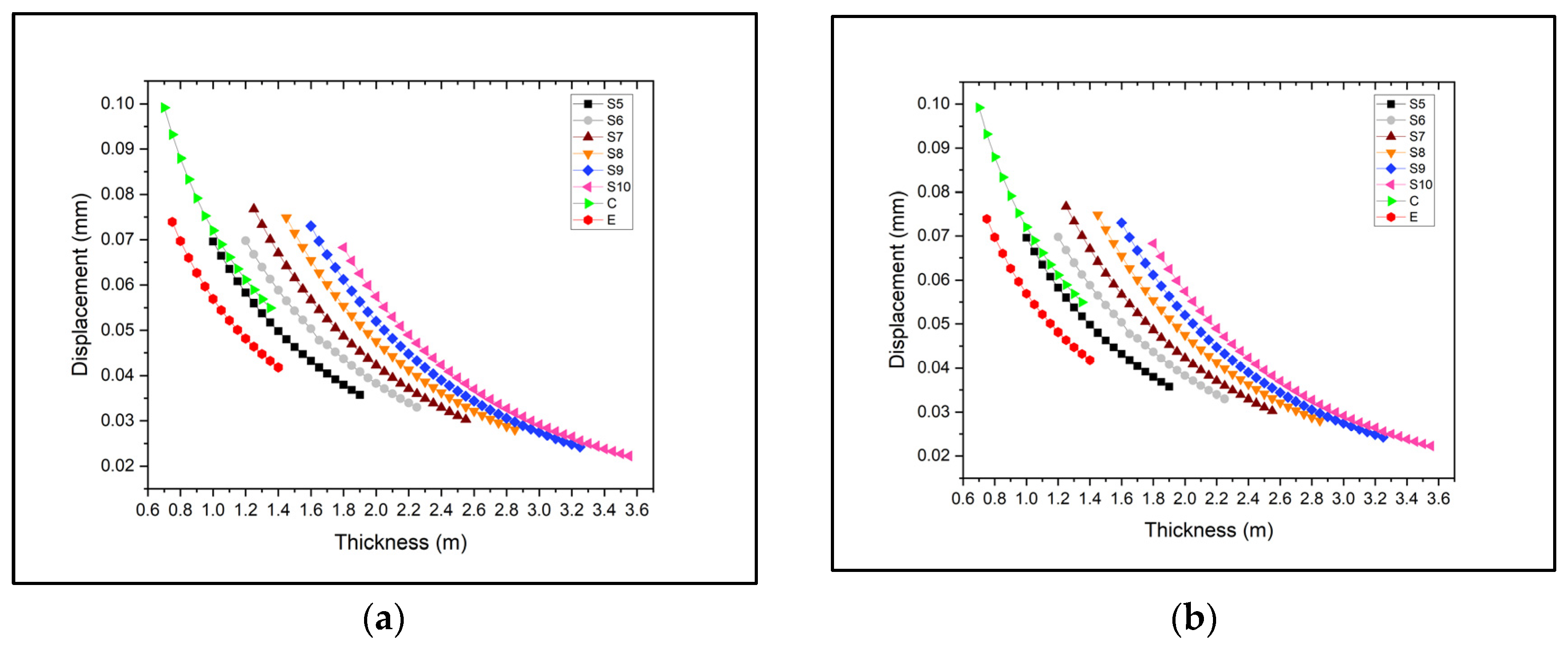
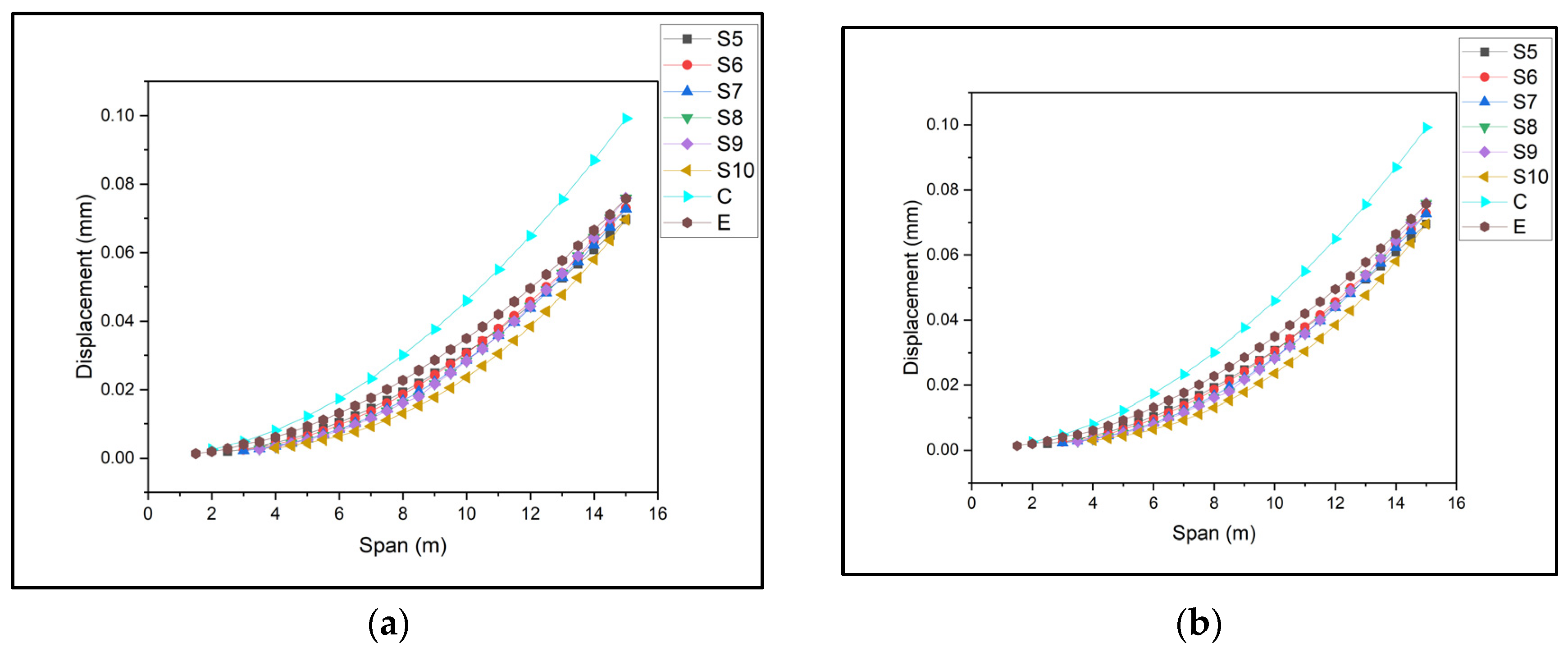
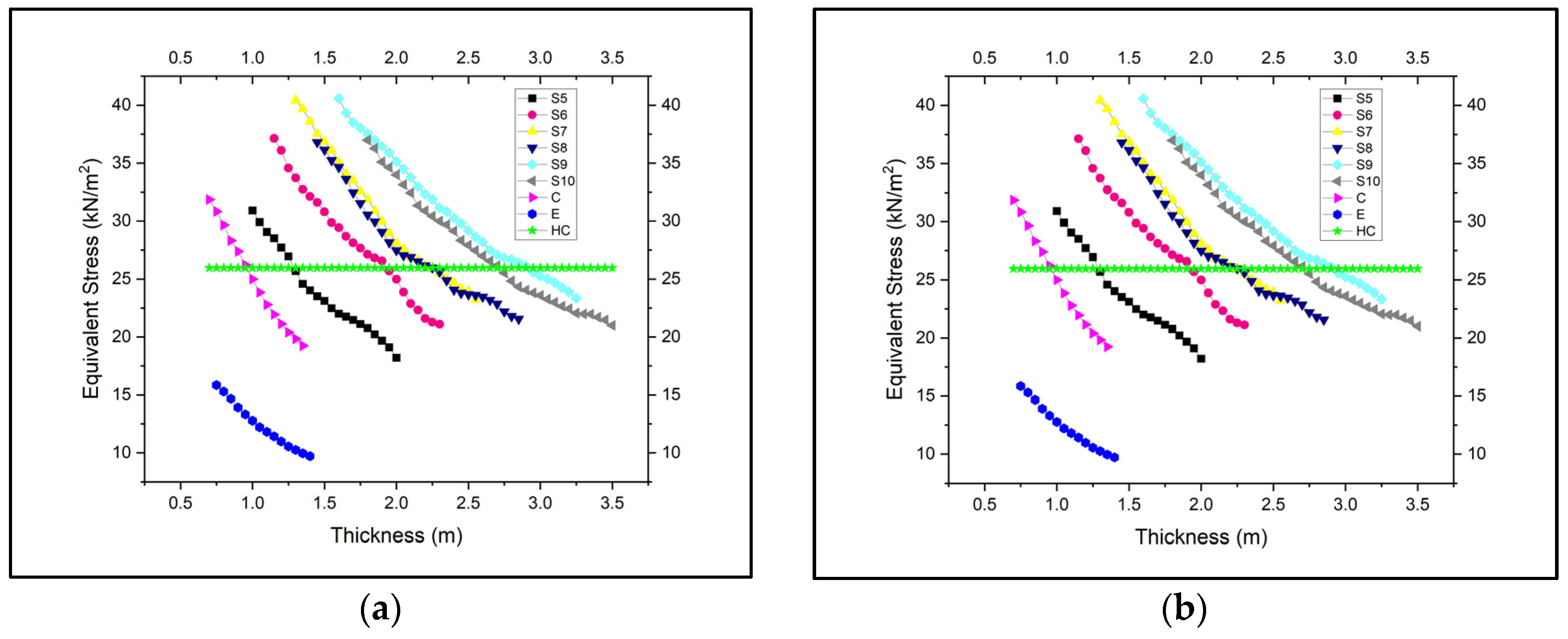

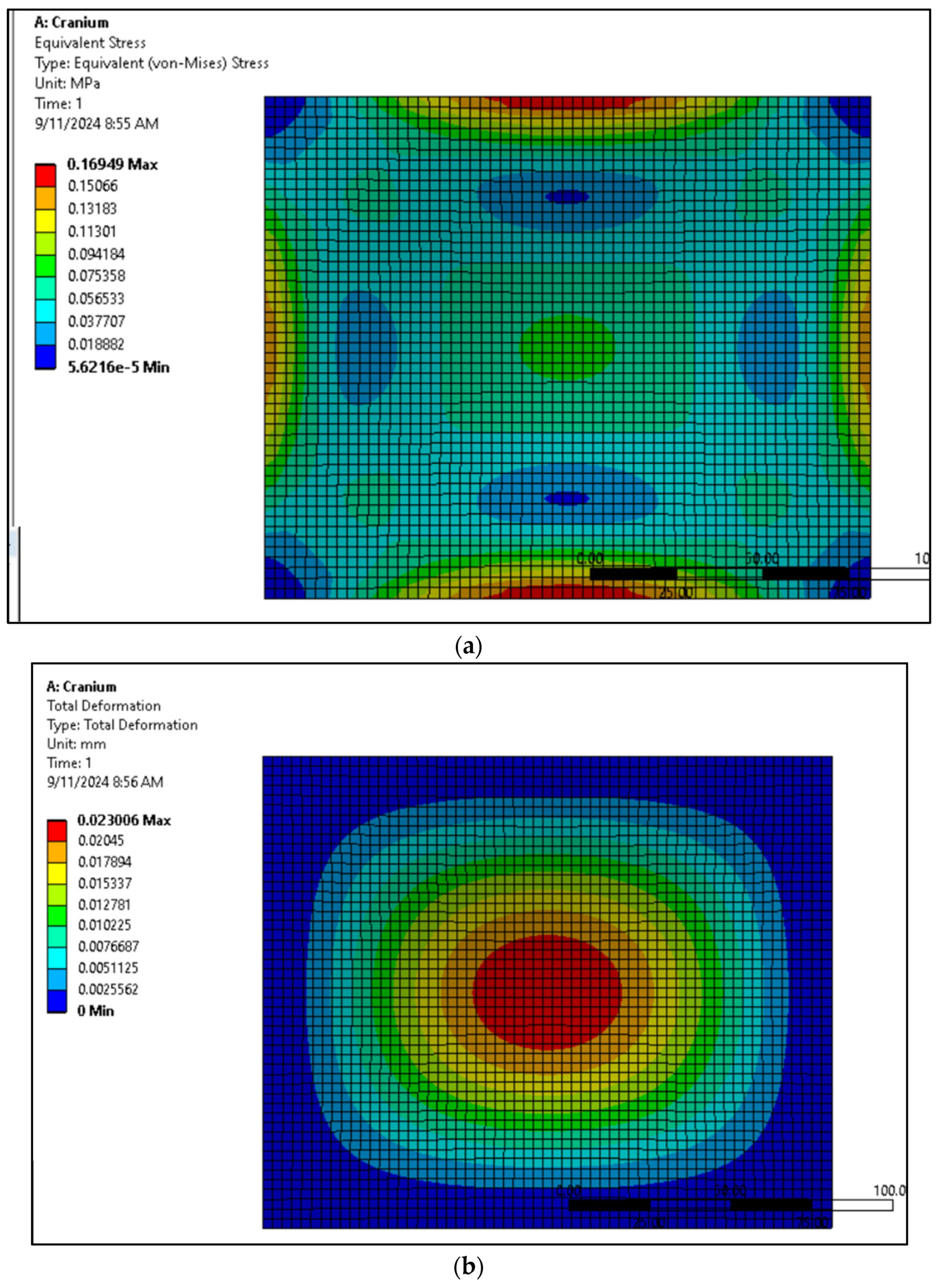
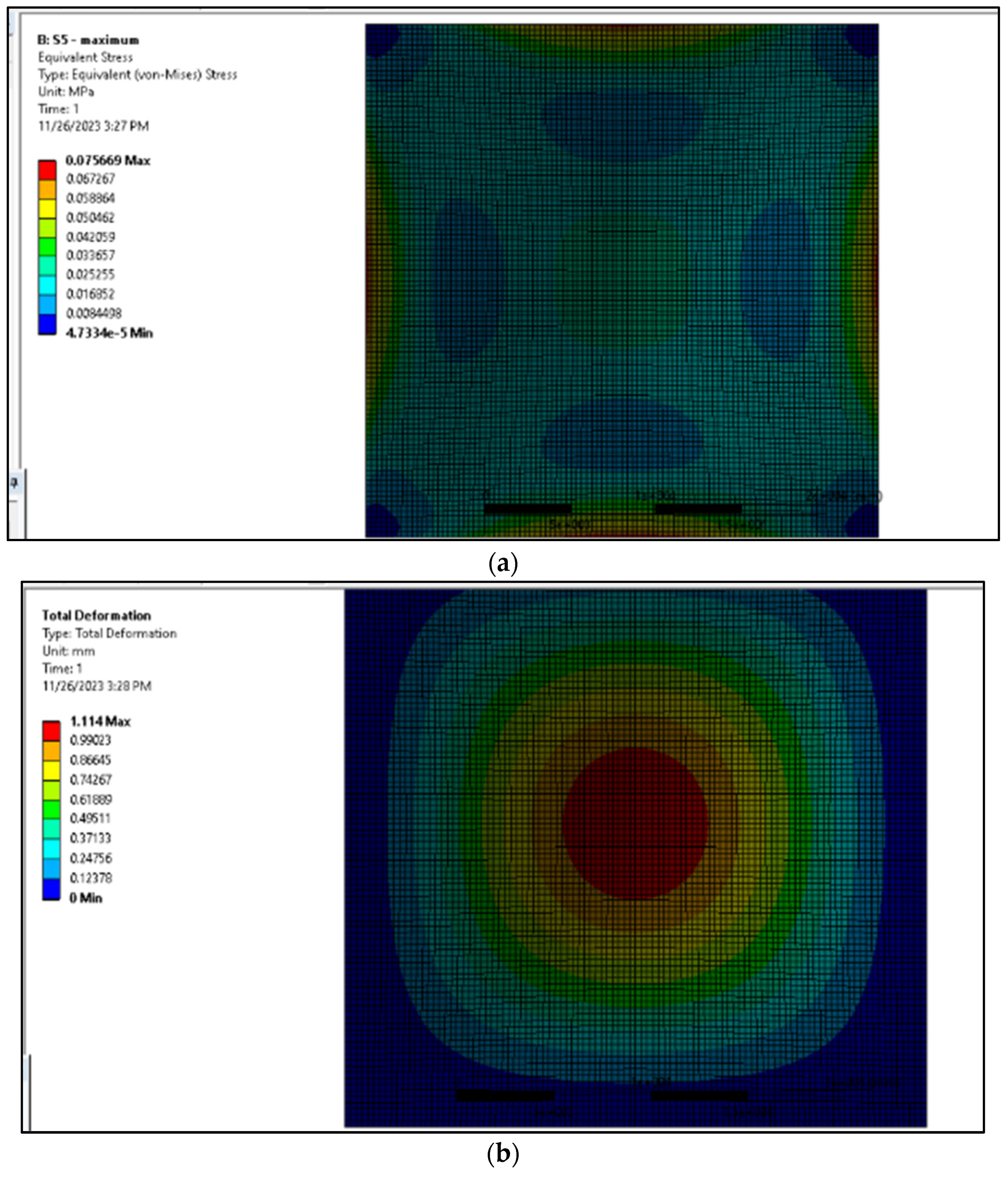
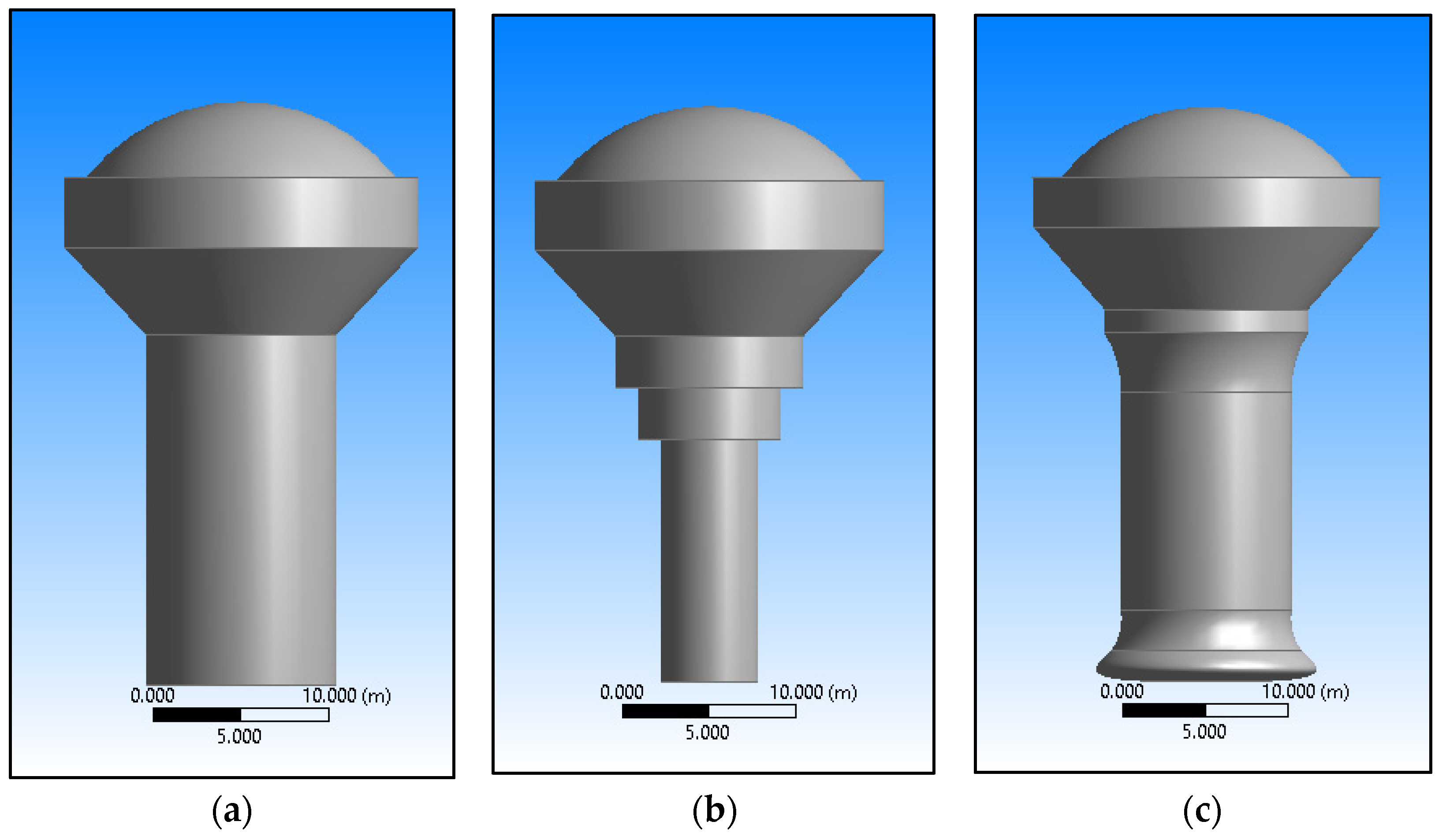
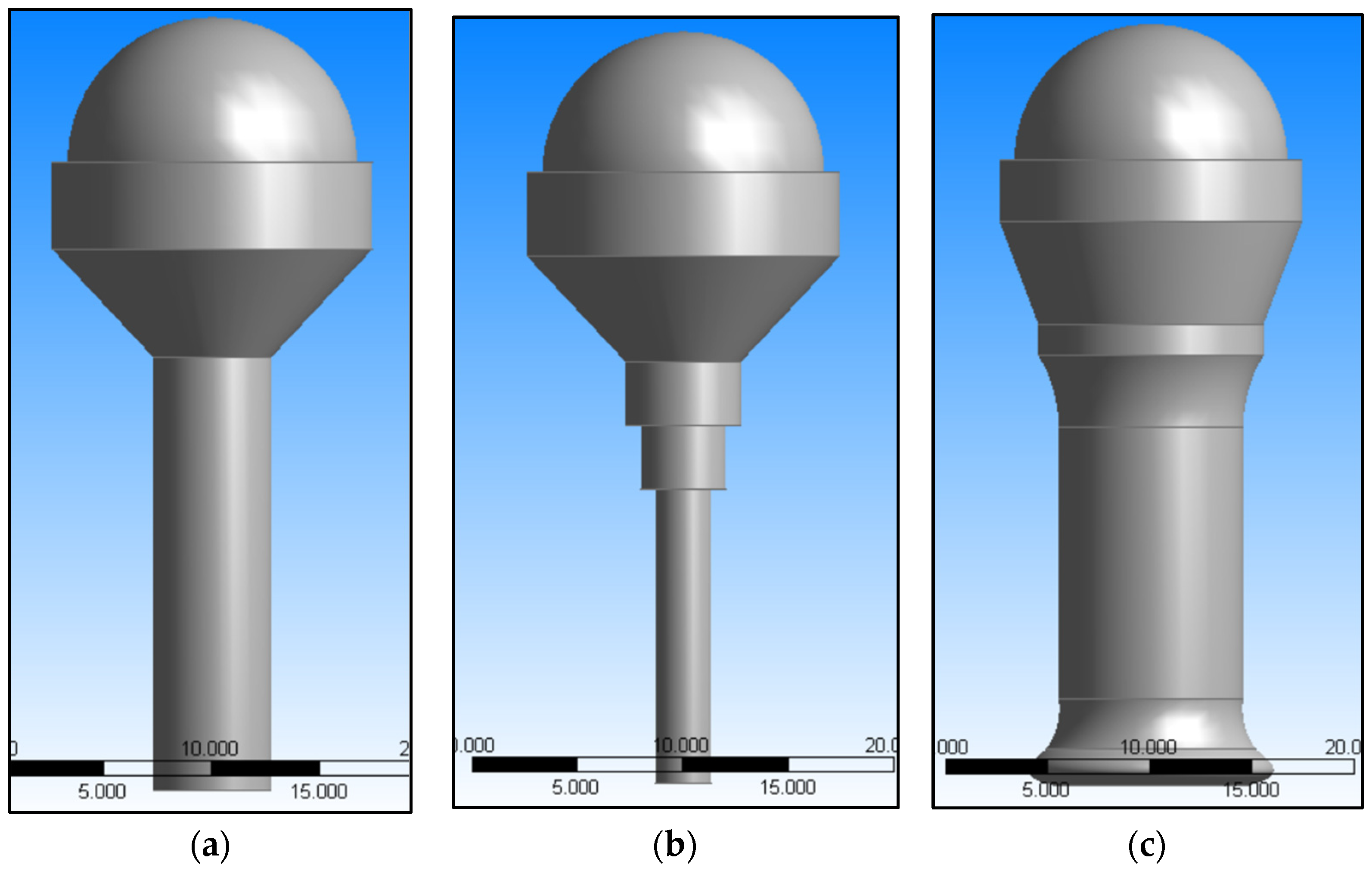
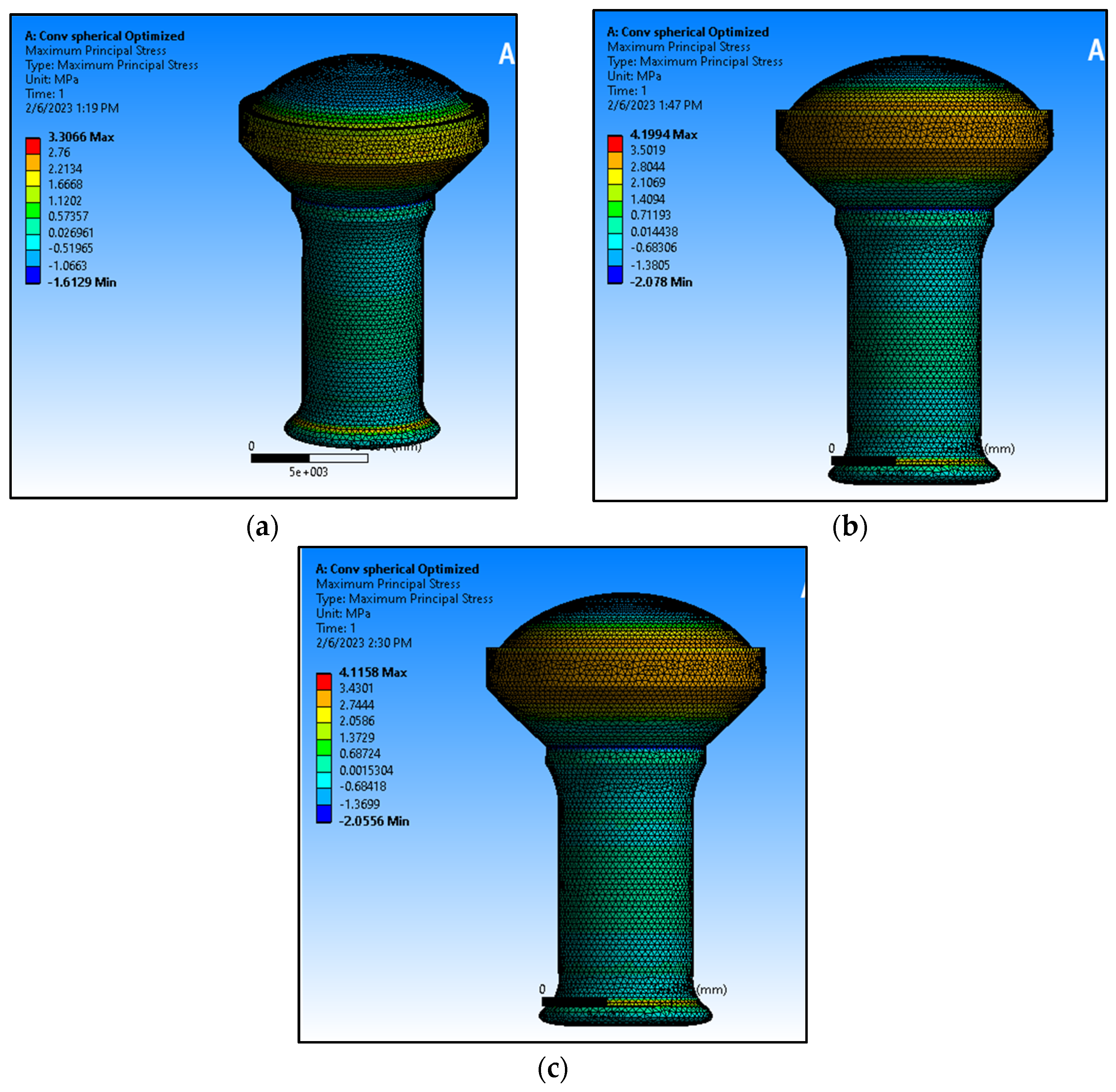

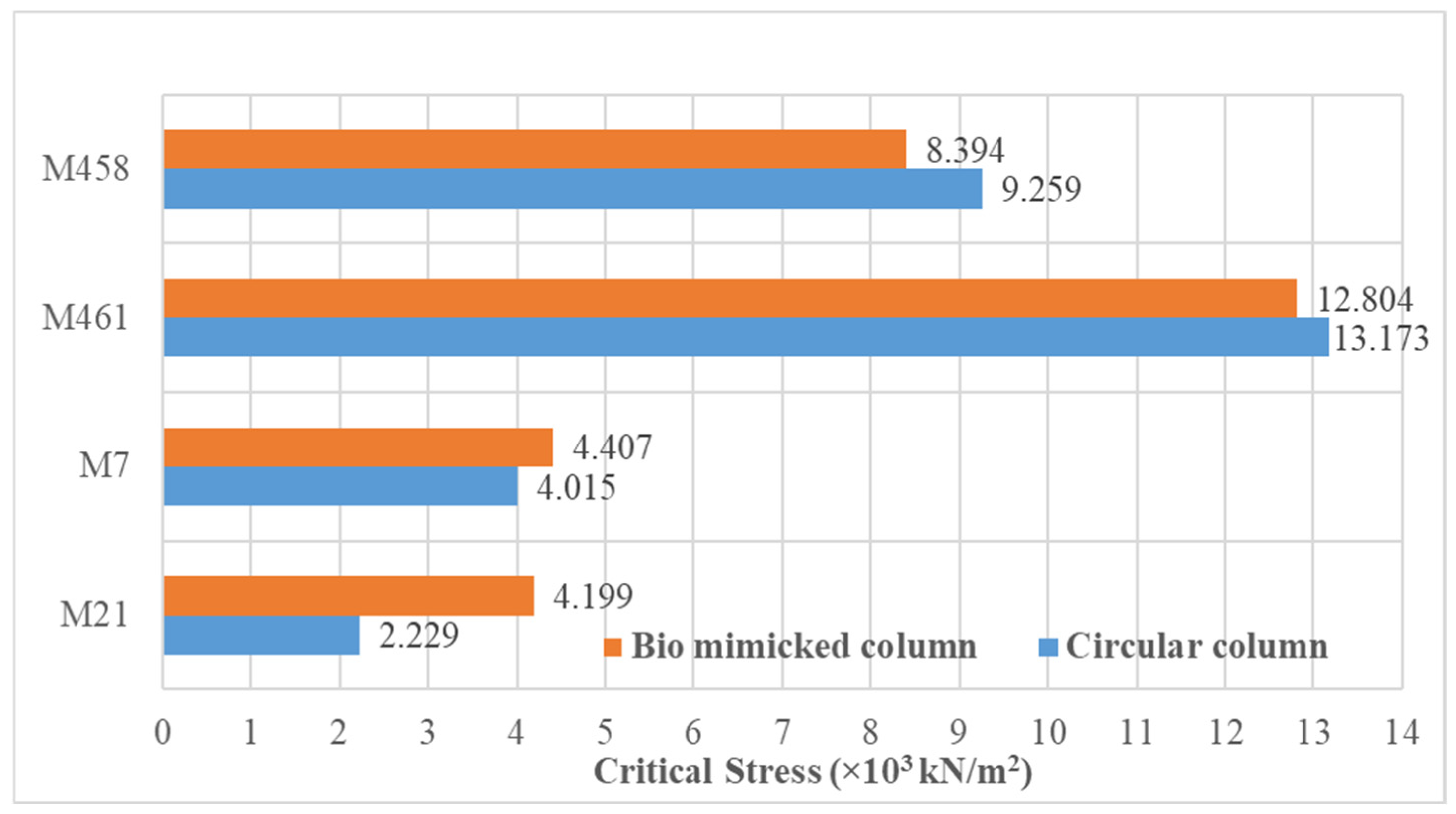
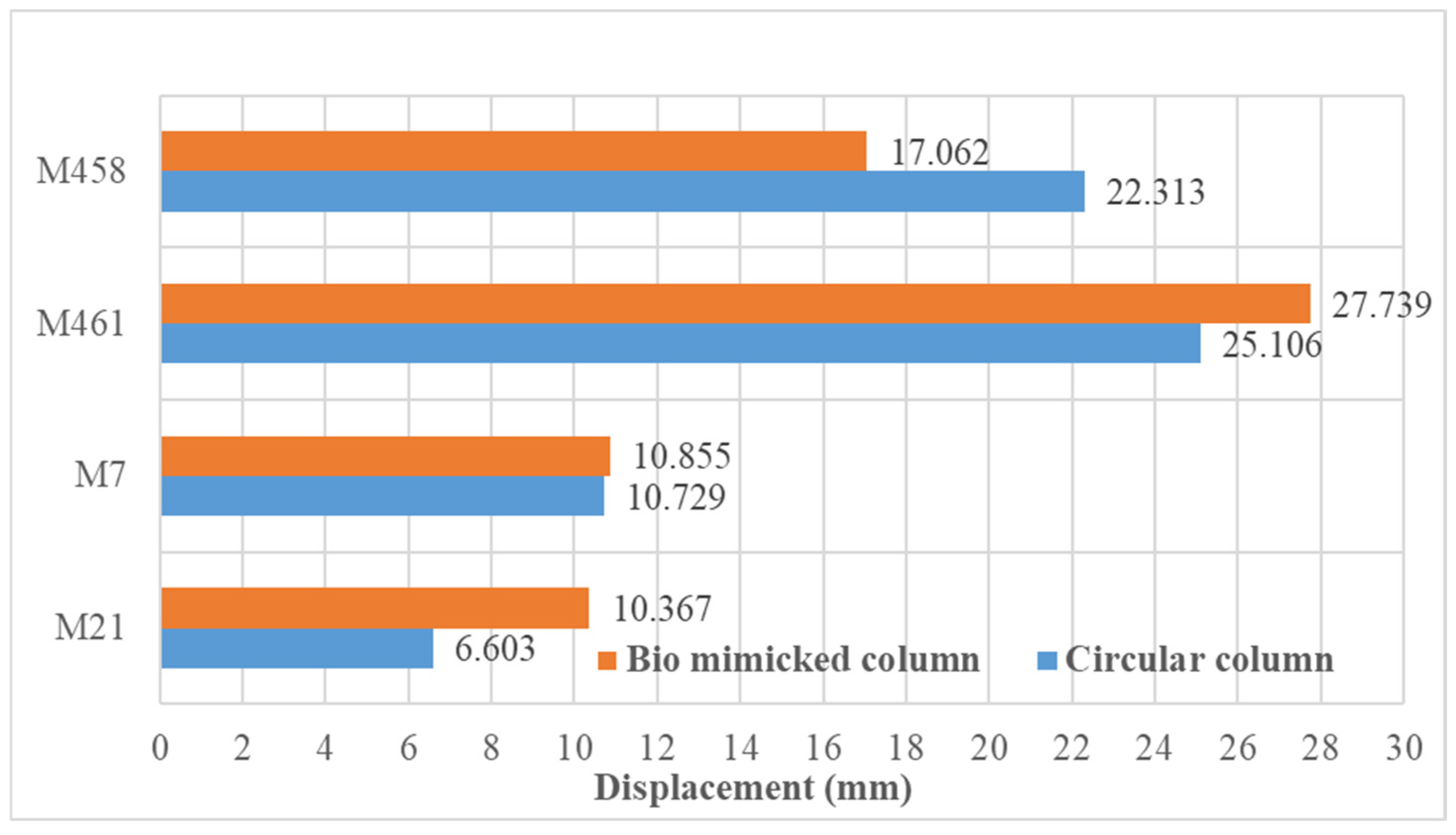
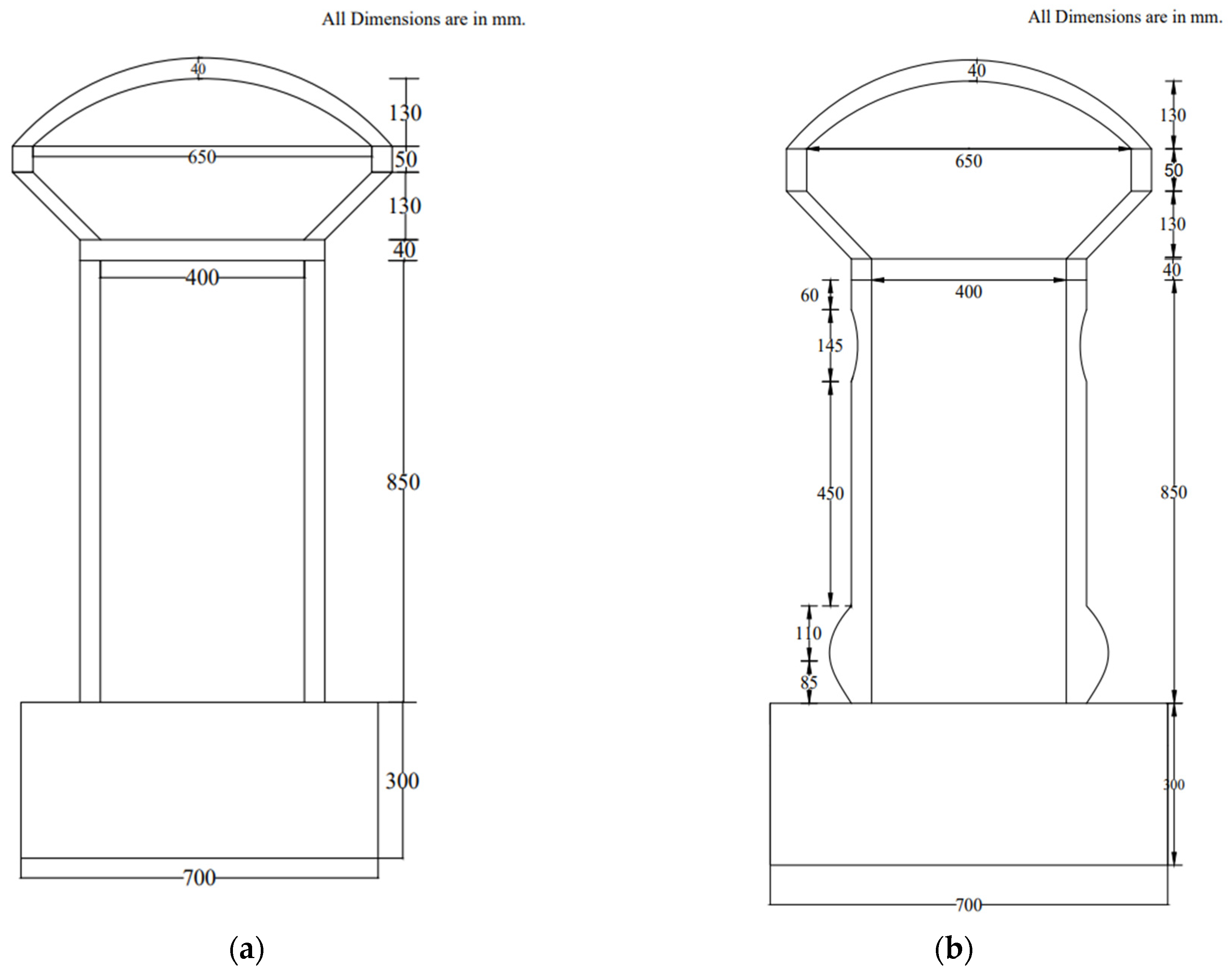
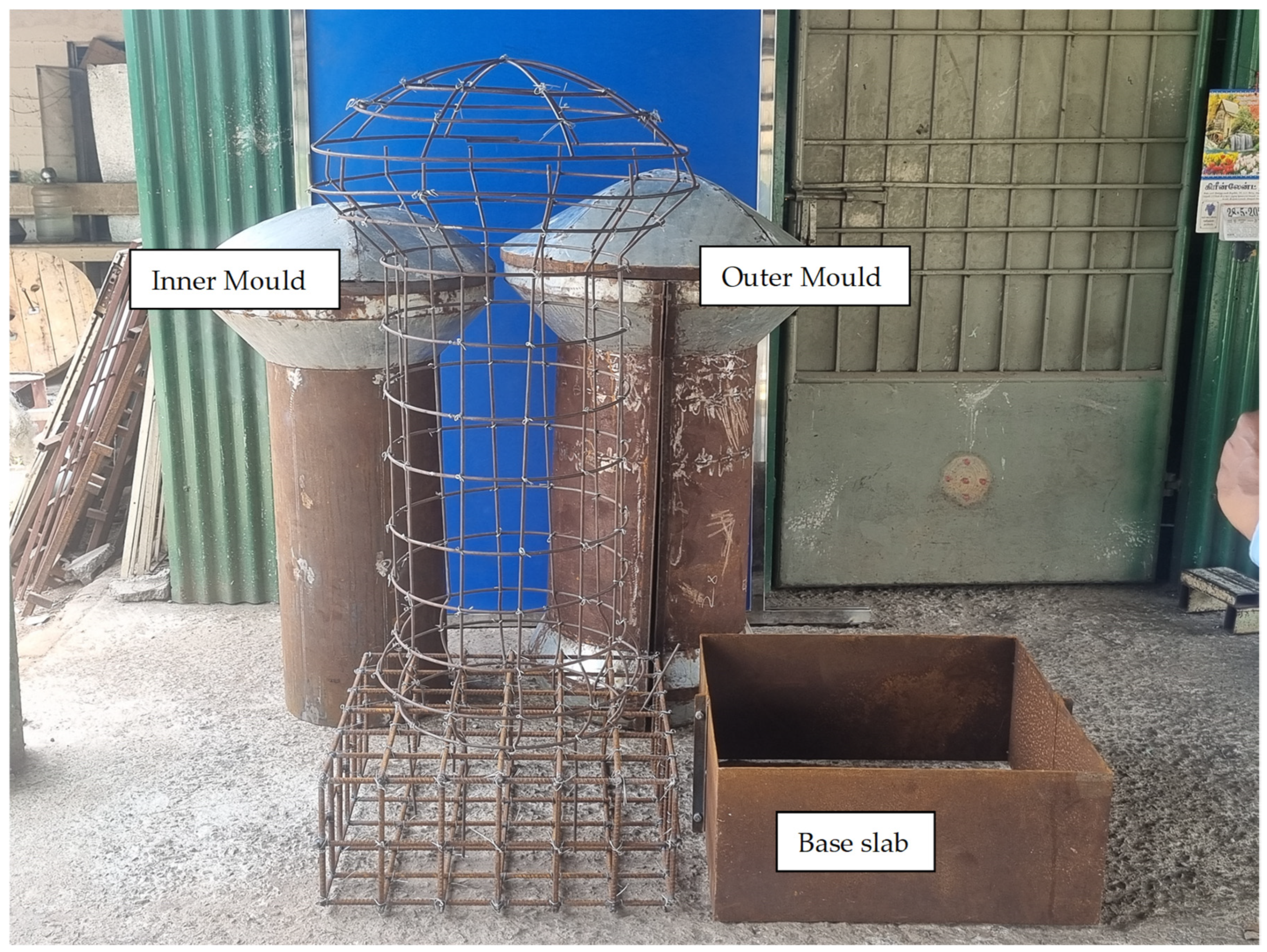

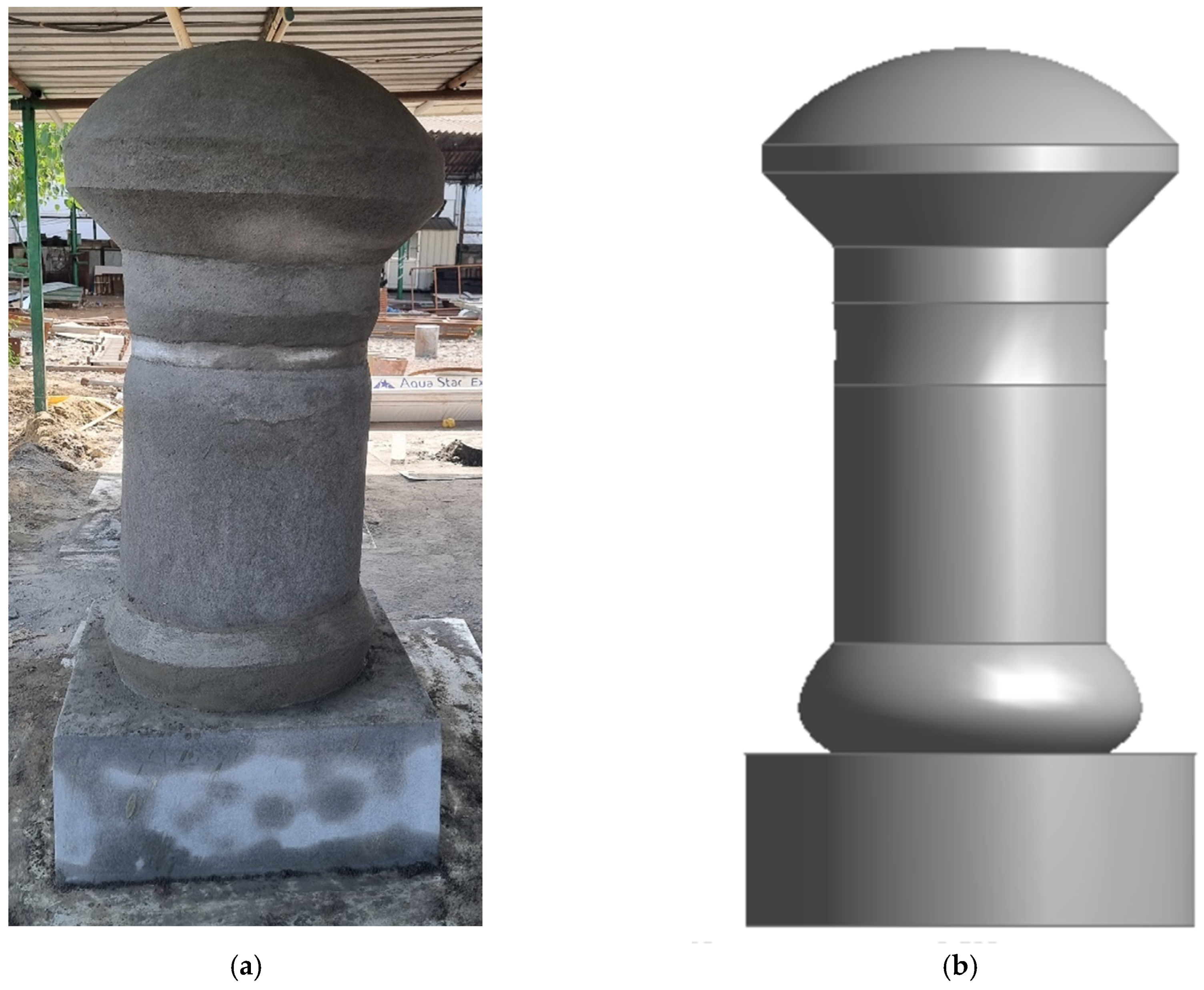
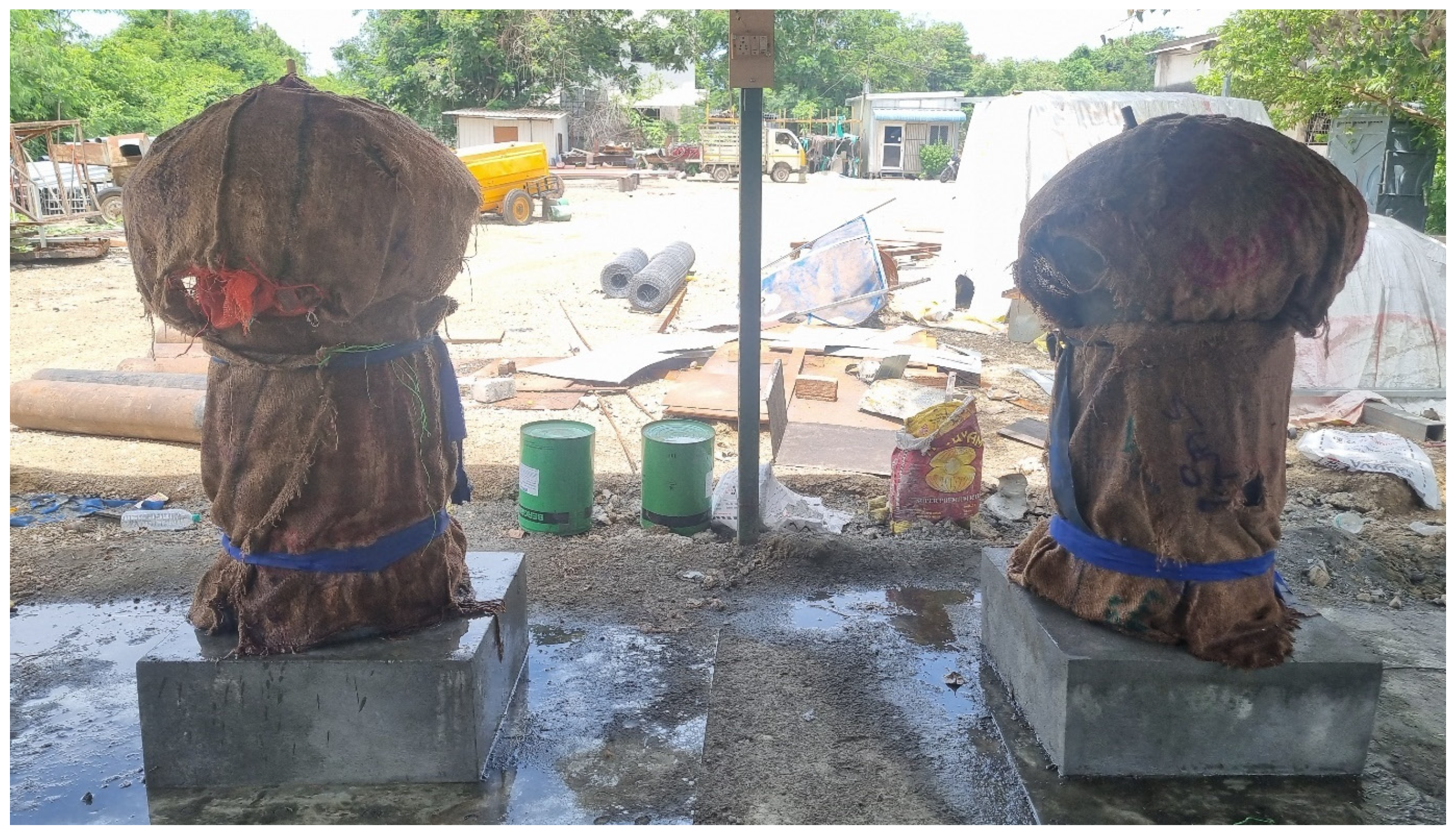
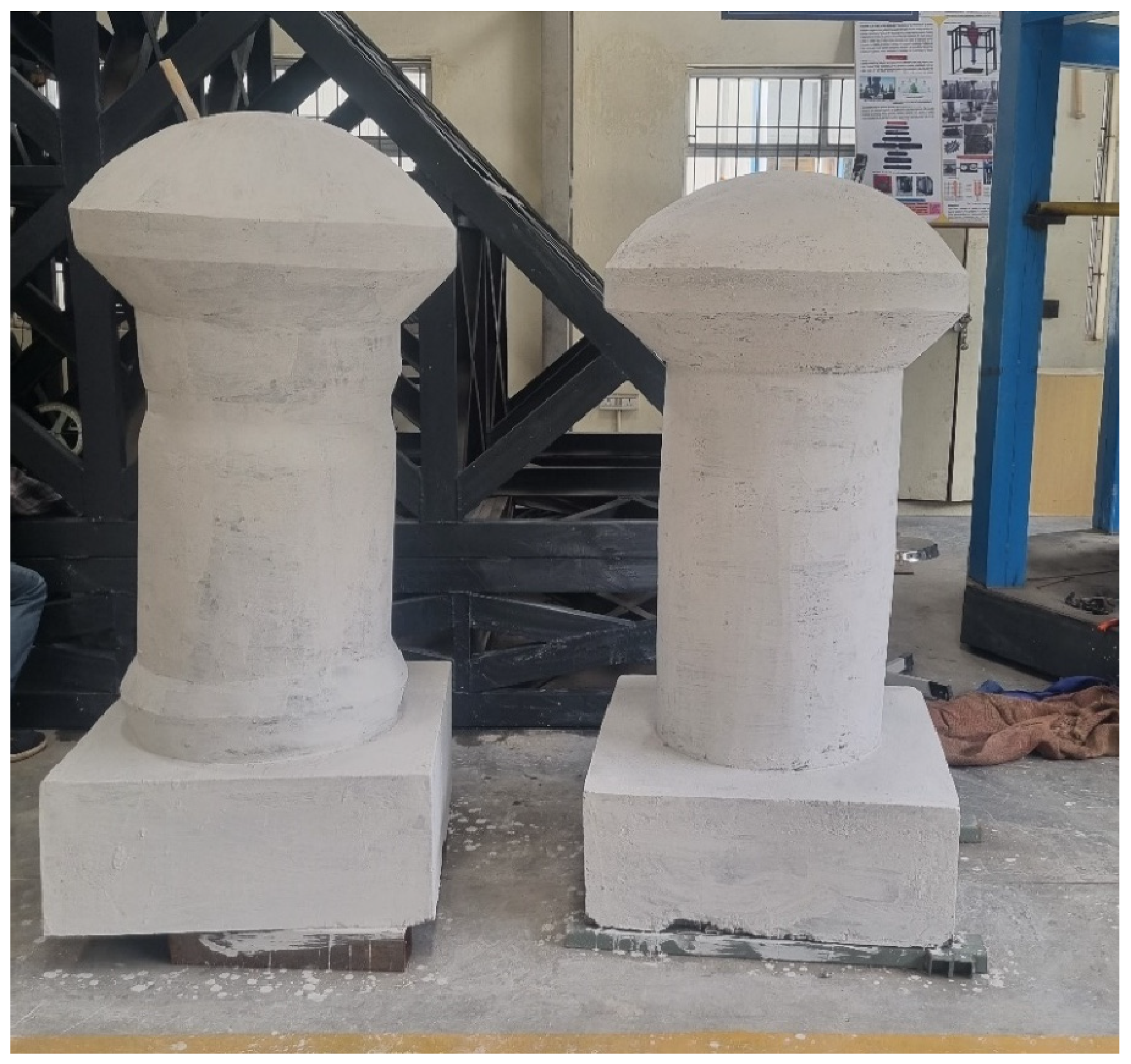

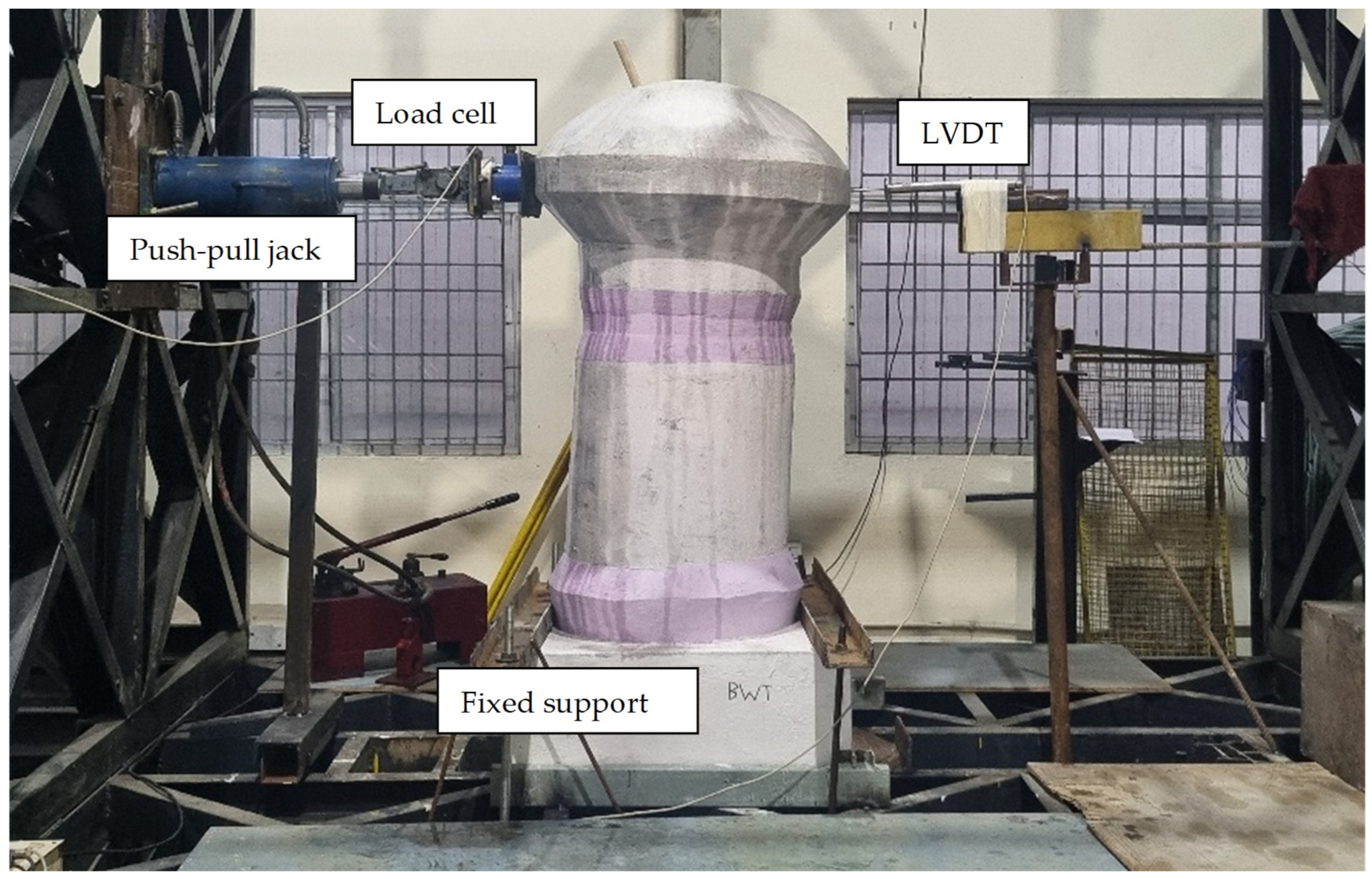


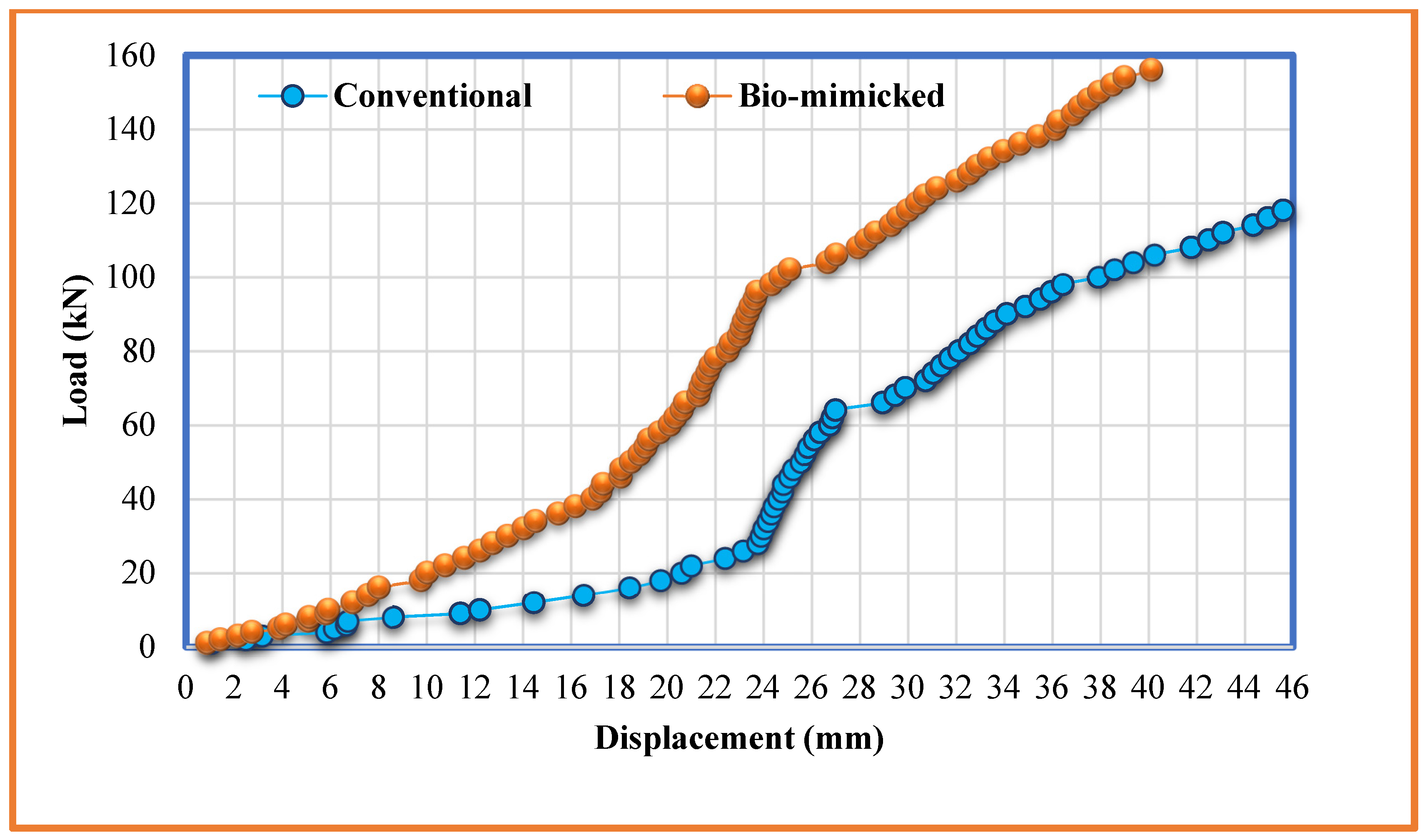
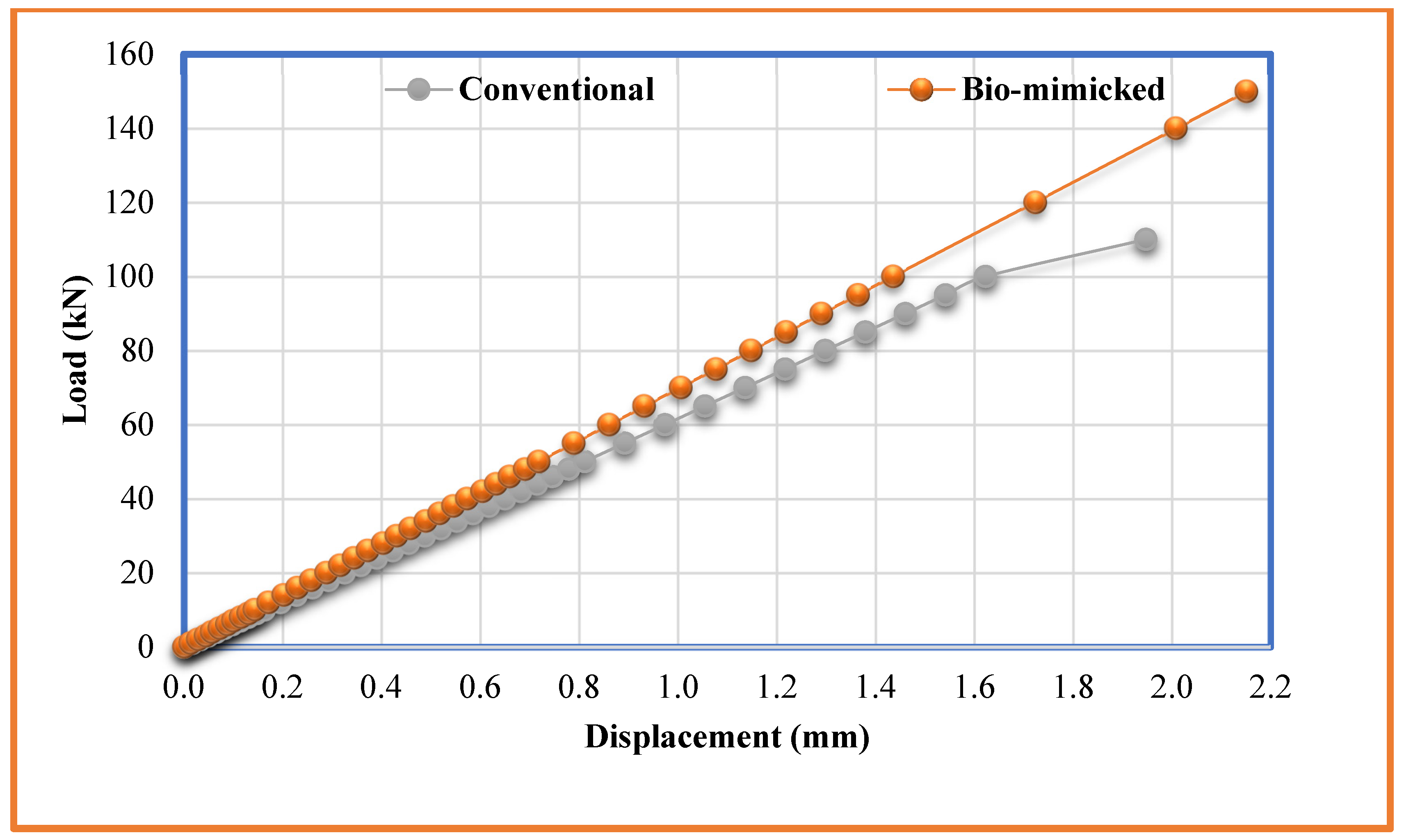

| Description | Values from the Literature [31,32] | Values from CT Images | ||
|---|---|---|---|---|
| Male | Female | Male | Female | |
| Anterior–posterior length (L) (m) | 0.186 | 0.177 | 0.175 | 0.170 |
| Breadth (B) (m) | 0.139 | 0.136 | 0.145 | 0.138 |
| Average thickness (t) (m) | 0.006 | 0.007 | 0.0064 | 0.0065 |
| Average height (H) (m) | Nil | 0.088 | 0.090 | |
| Cranial capacity (mm3) | 986.54 | 855.21 | ||
| ratio calculated | 10.80 | 11.10 | ||
| Descriptions | Value |
|---|---|
| Modulus of Elasticity (kN/m2) | 1.50 × 106 |
| Poisson’s Ratio | 0.21 |
| Density (kg/m3) | 1900 |
| Properties | OPC | Range [37,38] | ABP | Range [37,38] |
|---|---|---|---|---|
| Physical Properties | ||||
| Initial setting time (mins) | 35 | <30 | - | - |
| Final setting time (mins) | 400 | <600 | - | - |
| Consistency (%) | 31 | 27–35 | - | - |
| Fineness (%) | 3.1 | <10 | 3.17 | Around 3.18 |
| Specific gravity | 3.15 | 3.10–3.16 | 1.95 | 1.80–1.95 |
| Chemical Composition (in %) | ||||
| Calcium Oxide (CaO) | 64.30 | 60.00–70.00 | 63.54 | 53.2–76.31 |
| Silica Oxide (SiO2) | 20.18 | 17.00–25.00 | 2.04 | 0.24–2.28 |
| Magnesium Oxide (MgO) | 2.17 | 0.10–4.00 | 1.15 | 0.21–1.21 |
| Sodium Oxide (Na2O) | 1.06 | 0.40–1.30 | 1.60 | 0.37–1.70 |
| Potassium Oxide (K2O) | 0.50 | 0.40–1.30 | 0.25 | <0.30 |
| Aluminum Oxide (Al2O3) | 5.05 | 3.00–8.00 | 2.29 | <3.00 |
| Iron Oxide (Fe2O3) | 2.03 | 0.50–6.00 | 0.38 | <0.43 |
| Shape | Parameter | = 10.80 | = 11.10 | |
|---|---|---|---|---|
| Spherical shell (S5–S10) | Span | 0.60 to 30.00 m | 0.62 to 30.00 m | |
| Rise | 0.12 to 6.00 m | 0.12 to 6.00 m | ||
| Thickness | 0.04 to 2.00 m | 0.04 to 1.96 m | ||
| Span | 0.52 to 30.00 m | 0.54 to 30.00 m | ||
| Rise | 0.09 to 5.00 m | 0.09 to 5.00 m | ||
| Thickness | 0.04 to 2.30 m | 0.04 to 2.25 m | ||
| Span | 0.46 to 30.00 m | 0.47 to 30.00 m | ||
| Rise | 0.06 to 4.20 m | 0.06 to 4.20 m | ||
| Thickness | 0.04 to 2.63 m | 0.04 to 2.56 m | ||
| Span | 0.41 to 30.00 m | 0.42 to 30.00 m | ||
| Rise | 0.05 to 3.75 m | 0.06 to 3.75 m | ||
| Thickness | 0.04 to 2.95 m | 0.04 to 2.87 m | ||
| Span | 0.37 to 30.00 m | 0.38 to 30.00 m | ||
| Rise | 0.04 to 3.33 m | 0.04 to 3.33 m | ||
| Thickness | 0.04 to 3.25 m | 0.04 to 3.15 m | ||
| Span | 0.35 to 30.00 m | 0.34 to 30.00 m | ||
| Rise | 0.03 to 3.00 m | 0.03 to 3.00 m | ||
| Thickness | 0.04 to 3.61 m | 0.04 to 3.51 m | ||
| Circular shell (C) | Span | 1.00 to 30.00 m | 1.00 to 30.00 m | |
| Rise | 0.5 to 15.00 m | 0.5 to 15.00 m | ||
| Thickness | 0.04 to 1.38 m | 0.04 to 1.35 m | ||
| Elliptical shell (E) | (1.36) | Major axis | Nil (as the rise of the cranium does not support any standards) | 0.84 to 30.00 m |
| Minor axis | 0.61 to 11.00 m | |||
| Thickness | 0.04 to 1.42 m |
| Shape | Criterion 1 | |||||||
|---|---|---|---|---|---|---|---|---|
| Model | 10.803 | Model | 11.101 | |||||
| Span (m) | Rise (m) | Thickness (m) | Span (m) | Rise (m) | Thickness (m) | |||
| S5 | M7 | 15.00 | 3.00 | 1.30 | M7 | 15.00 | 3.00 | 1.30 |
| S6 | M63 | 15.00 | 2.50 | 1.90 | M63 | 15.00 | 2.50 | 1.90 |
| S7 | M144 | 15.00 | 2.14 | 2.25 | M144 | 15.00 | 2.14 | 2.25 |
| S8 | M217 | 15.00 | 1.88 | 2.25 | M217 | 15.00 | 1.88 | 2.25 |
| S9 | M304 | 15.00 | 1.67 | 2.90 | M304 | 15.00 | 1.67 | 2.90 |
| S10 | M317 | 15.00 | 1.50 | 2.70 | M317 | 15.00 | 1.50 | 2.70 |
| C | M439 | 15.00 | 7.50 | 0.95 | M439 | 15.00 | 7.50 | 0.95 |
| Shape | Criterion 2 | |||||||
|---|---|---|---|---|---|---|---|---|
| Model | 10.803 | Model | 11.101 | |||||
| Span (m) | Rise (m) | Thickness (m) | Span (m) | Rise (m) | Thickness (m) | |||
| S5 | M44 | 13.50 | 2.70 | 1.00 | M44 | 13.50 | 2.70 | 1.00 |
| S6 | M88 | 11.00 | 1.83 | 1.17 | M113 | 11.00 | 1.83 | 1.15 |
| S7 | M165 | 10.00 | 1.43 | 1.34 | M190 | 10.00 | 1.43 | 1.30 |
| S8 | M243 | 10.00 | 1.25 | 1.50 | M267 | 10.00 | 1.25 | 1.45 |
| S9 | M319 | 10.00 | 1.11 | 1.65 | M342 | 10.00 | 1.11 | 1.60 |
| S10 | M400 | 10.00 | 1.00 | 1.83 | M423 | 10.00 | 1.00 | 1.78 |
| C | M458 | 12.00 | 6.00 | 0.70 | M458 | 12.00 | 6.00 | 0.70 |
| Models Selected | Minimum Stress (kN/m2) | Maximum Stress (kN/m2) | Average Stress (kN/m2) | Ratio of Maximum to Average Stress |
|---|---|---|---|---|
| HC | 0.304 | 25.963 | 13.134 | 1.98 |
| Criterion 1 | ||||
| S5(M7) | 1.462 | 26.151 | 13.806 | 1.89 |
| S6(M63) | 0.472 | 26.571 | 13.521 | 1.96 |
| C(M439) | 0.066 | 26.214 | 13.139 | 1.99 |
| Criterion 2 | ||||
| C(M458) | 0.211 | 26.628 | 13.420 | 1.98 |
| Description | M21 | M461 | ||||
|---|---|---|---|---|---|---|
| Circular Column | Stepped Column | Bio-Mimicked Column | Circular Column | Stepped Column | Bio-Mimicked Column | |
| Filled with water | ||||||
| Maximum Principal Stress (×103 kN/m2) | 1.552 | 8.184 | 3.307 | 7.332 | 7.269 | 6.501 |
| Displacement (mm) | 5.115 | 11.144 | 7.988 | 11.689 | 17.918 | 12.902 |
| Half-filled with water | ||||||
| Maximum Principal Stress (×103 kN/m2) | 2.229 | 10.337 | 4.199 | 13.173 | 13.066 | 12.804 |
| Displacement (mm) | 6.603 | 14.244 | 10.367 | 25.106 | 37.302 | 27.739 |
| No water (empty) | ||||||
| Maximum Principal Stress (×103 kN/m2) | 2.209 | 10.034 | 4.115 | 12.892 | 12.790 | 12.607 |
| Displacement (mm) | 6.528 | 13.976 | 10.242 | 24.777 | 36.709 | 27.429 |
| Description | M7 | M458 | ||||
|---|---|---|---|---|---|---|
| Circular Column | Stepped Column | Bio-mimicked Column | Circular Column | Stepped Column | Bio-mimicked Column | |
| Filled with water | ||||||
| Maximum Principal Stress (×103 kN/m2) | 2.847 | 4.908 | 2.813 | 5.175 | 7.147 | 4.247 |
| Displacement (mm) | 8.333 | 13.905 | 7.625 | 10.692 | 23.572 | 7.922 |
| Half-filled with water | ||||||
| Maximum Principal Stress (×103 kN/m2) | 4.015 | 6.062 | 4.407 | 9.259 | 14.013 | 8.394 |
| Displacement (mm) | 10.729 | 17.579 | 10.855 | 22.313 | 47.521 | 17.062 |
| No water (empty) | ||||||
| Maximum Principal Stress (×103 kN/m2) | 3.999 | 5.877 | 4.386 | 9.047 | 13.734 | 8.294 |
| Displacement (mm) | 10.587 | 17.230 | 9.753 | 21.962 | 46.616 | 16.907 |
| Type of Specimen | Numerical Values (Load in kN) | Numerical Values (Stress in MPa) | Capacity Ratio (Load) | Capacity Ratio (Stress) |
|---|---|---|---|---|
| Conventional | 110 | 38.03 | 1.00 | 1.00 |
| Bio-mimicked | 150 | 112.98 | 1.36 | 4.05 |
| Type of Specimen | Experimental Values (Load in kN) | Experimental Values (Stress in MPa) | Capacity Ratio (Load) | Capacity Ratio (Stress) |
|---|---|---|---|---|
| Conventional | 118 | 88.07 | 1.00 | 1.00 |
| Bio-mimicked | 156 | 246.44 | 1.32 | 2.80 |
| Type of Specimen | Experimental Load at (kN) | Experimental Displacement at (mm) | Numerical Load at (kN) | Numerical Displacement at (mm) | ||||
|---|---|---|---|---|---|---|---|---|
| Ultimate | Service | Ultimate | Service | Ultimate | Service | Ultimate | Service | |
| Conventional | 118 | 98 | 45.61 | 36.45 | 110 | 90 | 1.95 | 1.46 |
| Bio-mimicked | 156 | 130 | 40.14 | 32.89 | 150 | 120 | 2.15 | 1.72 |
Disclaimer/Publisher’s Note: The statements, opinions and data contained in all publications are solely those of the individual author(s) and contributor(s) and not of MDPI and/or the editor(s). MDPI and/or the editor(s) disclaim responsibility for any injury to people or property resulting from any ideas, methods, instructions or products referred to in the content. |
© 2024 by the authors. Licensee MDPI, Basel, Switzerland. This article is an open access article distributed under the terms and conditions of the Creative Commons Attribution (CC BY) license (https://creativecommons.org/licenses/by/4.0/).
Share and Cite
Gunasekaran, P.; Rajkumar, P.R.K. Numerical and Experimental Validation for Connecting Nature with Architecture by Mimicking Cranium into a Shell Roof. Buildings 2024, 14, 2966. https://doi.org/10.3390/buildings14092966
Gunasekaran P, Rajkumar PRK. Numerical and Experimental Validation for Connecting Nature with Architecture by Mimicking Cranium into a Shell Roof. Buildings. 2024; 14(9):2966. https://doi.org/10.3390/buildings14092966
Chicago/Turabian StyleGunasekaran, Pennarasi, and P. R. Kannan Rajkumar. 2024. "Numerical and Experimental Validation for Connecting Nature with Architecture by Mimicking Cranium into a Shell Roof" Buildings 14, no. 9: 2966. https://doi.org/10.3390/buildings14092966






